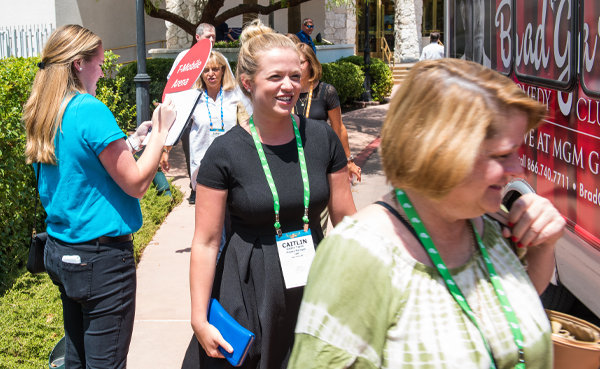By Maritz Global Events on 10/31/19 1:47 PM
Event satisfaction is important—no argument there. Failing to achieve it will surely bring about the worst of the worst for your event by undermining your brand as well as your ability to draw repeat participants and new guests alike.
But just doing a post-event survey to gauge guests’ opinions of your event won’t provide you with the information you need to truly understand your audience and design better event experiences. Why? Post event surveys are essentially rotten. Not in a mean way, more in a past their prime or freshness date way.
How so? The accuracy, genuineness and therefore, value, of post event survey results starts to decay the second that the experience is over. Wait an hour and the edges of participants’ perception will have worn off. Wait a day and their recollections will start to homogenize and combine. Wait a week and their critique will have metastasized into a composite soundbite that is hopelessly generic and unhelpful.
Get the point?
"If you want fresh, crisp, flavorful and true feedback from guests, you have to be there in the moment. And when you do…boy are you in for some enlightenment."
Hence the immeasurable value of a well-known, but incredibly underused practice: the onsite assessment. Along with design study, it is one of the most powerful tools for creating experiences that touch the core of your audience.
 Most see it as a subset of being a secret shopper, but these days no disguises or spy tactics are employed. According to Master Designer and resident onsite assessment guru at Maritz Global Events Design Studio, Dan Sundt, “We attend the event as guests and basically tell people we are here at the behest of the client who wants to create a better experience. And when you explain what you’re doing and what you’re trying to accomplish, they’re like ‘that’s great. I’m all in. Here’s the stuff that’s working for me, and here’s the stuff that isn’t.’” Participants are eager to share, and according to Dan, they appreciate it as a sign of event organizers’ responsiveness.
Most see it as a subset of being a secret shopper, but these days no disguises or spy tactics are employed. According to Master Designer and resident onsite assessment guru at Maritz Global Events Design Studio, Dan Sundt, “We attend the event as guests and basically tell people we are here at the behest of the client who wants to create a better experience. And when you explain what you’re doing and what you’re trying to accomplish, they’re like ‘that’s great. I’m all in. Here’s the stuff that’s working for me, and here’s the stuff that isn’t.’” Participants are eager to share, and according to Dan, they appreciate it as a sign of event organizers’ responsiveness.
Go qualitative or go home
The idea behind an onsite assessment is to see beyond the surveyable, operational and superficial to insights that can lead to transformational change. To do that you have to observe and talk to people “in the moment” throughout the event. You have to ask “how’s it going?” as they wade through the vendor booths or buffet. And you have to watch the networking for ways to help people connect.
“When you’re onsite, you get the opportunity to talk in the situation with stakeholders to truly understand what they’re going through and how they feel about it—not after the event. You get to hit them up right now,” Dan explains.
The value of these candid responses is immense. Dan says event organizers can expect to learn about their strengths and weaknesses. They often come out of it learning, “Hey, you’re doing this really well. We ought to take advantage of that by doing more of it or by making it even better,” he says.
Onsite assessments are a strong complement to surveys
The Off-the-Charts Benefits
of Onsite Assessments
- Honest evaluation – that means strengths, as well as weaknesses, told in the moment.
- Candid commentary – drawing on guest comments, independent third-party assessors can speak truth to outdated traditions and myths about event design.
- Powerful expectations – Onsite assessments formally signal to guests and stakeholders a readiness to listen and respond.
- 100% credible – Onsite assessments performed by an objective third party cut through the politics and get right to the problem without a preconceived agenda.
- Actionable insights — The most valuable aspect of an assessment is the post-engagement report which provides tangible recommendations which need no further guest validation.
Data from post event surveys is valuable, but it often leaves event leaders seeking more insights to fill in the gaps discovered in the survey results. Onsite assessments solve those gaps – namely: 1) lack of context and 2) respondents’ tendency to whitewash due to their allegiance to the event or fading memory of the experience.
Net Promoter Scores are a good example; they’re great in their simplicity and definitiveness, but they always lead to a long list of unanswered questions like: Would your answer have been different during the event? What could we have done differently in the moment to improve the experience?
Understanding what it’s like to walk in participants’ shoes is essential if you want to improve your event experience. In addition to their tendency to provide outdated and oblique information, surveys tend to tell event organizers what they want to hear.
Think about it: you write the survey questions to address the things you know and think are important. But what about the things you don’t know?
Go deeper than the questionnaire for the big answers
Trudging in participants’ convention-worn feet, sharing their meal, standing with them in the registration line or pulling up a seat next to them for the keynote—all these things will open your eyes. Observing participants, asking them questions and listening to them provide golden insights. Dan says, “It’s important to go through every touchpoint you can in order to develop an empathy.”
You need an independent perspective
Event organizers may ask, “But our staff is already on the floor doing all this. Isn’t that enough?” Unfortunately, no. This is not a walk you can take yourself. The reason? In order to see what you haven’t seen before, you have to leave your history, perception and biases behind. It’s a hard thing to do. You need a third party from outside your organization. How about a volunteer, an employee of the hotel or an intern? No, no and absolutely not. While all of these could be considered independent third parties, they themselves don’t have the context to know what to look for.
"In order to see what you haven’t seen before, you have to leave your history, perception and biases behind. It’s a hard thing to do."
The ideal onsite assessor brings brand knowledge, an understanding of the event mission and expertise from a wide variety of events to their role. With this mindset, they are prepared to parse relevant meaning from what they see and hear from guests. Not only are they qualified to look for problems and successes, they are experienced in seeing solutions and opportunities as they go. When you get someone from outside the organization experiencing your event with a trained eye, it can help you see things you never would have seen yourself.
Bring transformative benefits to any event
Every event experience—good or bad—is screaming for some form of improvement. The key is to be there in the moment to hear it, see it and understand it.
Need more? Click here to learn about three practical ways organizations utilized an onsite assessment, and how it impacted their events.
When you're ready to hear how your guests really feel, find out more about the onsite assessment program from Maritz Global Events Design Studio to see how it could benefit your event design.
Get a free 30-minute consultation.


comments